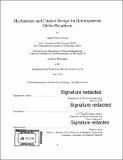| dc.contributor.advisor | Yuriy Román-Leshkov. | |
| dc.contributor.author | Consoli, Daniel Francis. | en_US |
| dc.contributor.other | Massachusetts Institute of Technology. Department of Chemical Engineering. | en_US |
| dc.date.accessioned | 2021-10-15T15:23:31Z | |
| dc.date.available | 2021-10-15T15:23:31Z | |
| dc.date.copyright | 2019 | en_US |
| dc.date.issued | 2019 | en_US |
| dc.identifier.uri | https://hdl.handle.net/1721.1/132981 | |
| dc.description | Thesis: Ph. D., Massachusetts Institute of Technology, Department of Chemical Engineering, June, 2019 | en_US |
| dc.description | Cataloged from PDF version of thesis. "Due to the condition of the original material, there are unavoidable flaws in this reproduction. We have made every effort possible to provide you with the best copy available"--Disclaimer page. | en_US |
| dc.description | Includes bibliographical references. | en_US |
| dc.description.abstract | Olefin metathesis offers a promising technology for on-purpose production of propylene and has been implemented in several industrial processes including the Lummus Olefin Conversion Technology. However, current metathesis technology cannot produce propylene cheaply and efficiently due to reliance on decades-old catalyst technology like tungsten oxide on silica. This poor performance can be attributed to a lack of understanding of heterogeneous metathesis reaction mechanisms and the catalysts involved. Current understanding proposes that olefin metathesis follows the Chauvin mechanism in which olefins coordinate with catalytic metal carbenes to form metallacyclobutanes that then rearrange into metathesis products. While this mechanism has been proven for homogenous metathesis catalysts, for which the 2005 Nobel Prize was awarded, the mechanism over heterogeneous catalysts may be more complicated as metal carbenes do not necessarily exist over freshly prepared material. In this thesis, we present a complete mechanistic cycle for heterogeneous olefin metathesis that comprises carbene site formation, stable metathesis, and active site decay. We demonstrate why this expanded mechanism is necessary to explain reaction order behavior for propylene on WO₃/SiO₂ and the presence of site formation byproducts during isobutene self-metathesis. Furthermore, we leverage our knowledge of the complete mechanism to introduce a secondary olefin to promote active site formation and, consequently, overall metathesis rate. Finally, we utilize our understanding of the importance of site formation to synthesize catalysts supported on tunable zeolite and metal organic framework materials that optimize metal-support interaction and metathesis rates. In sum, an improved understanding of the heterogeneous olefin metathesis mechanism has led to improvements in catalytic design, material characterization, and reactor operation. | en_US |
| dc.description.statementofresponsibility | by Daniel Francis Consoli. | en_US |
| dc.format.extent | 186 pages | en_US |
| dc.language.iso | eng | en_US |
| dc.publisher | Massachusetts Institute of Technology | en_US |
| dc.rights | MIT theses may be protected by copyright. Please reuse MIT thesis content according to the MIT Libraries Permissions Policy, which is available through the URL provided. | en_US |
| dc.rights.uri | http://dspace.mit.edu/handle/1721.1/7582 | en_US |
| dc.subject | Chemical Engineering. | en_US |
| dc.title | Mechanisms and catalyst design for heterogeneous Olefin metathesis | en_US |
| dc.type | Thesis | en_US |
| dc.description.degree | Ph. D. | en_US |
| dc.contributor.department | Massachusetts Institute of Technology. Department of Chemical Engineering | en_US |
| dc.identifier.oclc | 1263575086 | en_US |
| dc.description.collection | Ph.D. Massachusetts Institute of Technology, Department of Chemical Engineering | en_US |
| dspace.imported | 2021-10-15T15:23:31Z | en_US |
| mit.thesis.degree | Doctoral | en_US |
| mit.thesis.department | ChemEng | en_US |
